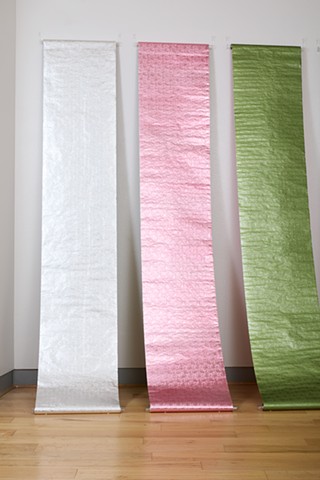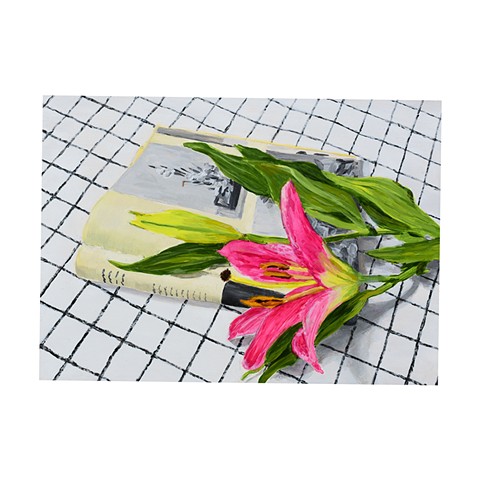HAPPENING
Photo by Marylene Mey, image courtesy of Form & Concept Center
With all the darkness that’s going on the world, you can look at the darkness, just don’t stare. It will make you crazy. It will make you cross eyed. It will make you what it is. The solution is to create magic, dance, sing, love. Create environments where you can create joy. Because you can create joy.
-RuPaul
Happening continues my exploration of the outmoded book Woman’s Own Book of Flower Arrangements, published in 1966. In Paintings for Our Mothers (2021), I transformed eleven copies of the book into a text-based sculptural artwork, deconstructing and subverting society’s false narratives on the status of women and the state of nature.
In this new translation of artworks, I made a series of memento mori drawings and paintings, focusing, this time, on the inner pages of the book. I equate the book’s dreary black-and-white photographs of dated flower arrangements and its “do and don’t” text instructions with the darkness happening in our current world. We seem to be moving backwards in time with the prevailing mobilization against women and LGBTQIA+ rights.
HAPPENING AIMS TO RESENSITIZE US TO THESE DISTURBING SOCIETAL REVERSALS WHILE SIMULTANEOUSLY CREATING AN IMAGE OF “PLEASANT-AS-POSSIBLE” MELANCHOLY AND THE HOPE THAT THIS TOO SHALL PASS. THESE WORKS REEXAMINE HOW FLOWERS HAVE BEEN USED AS SOCIAL TOOLS IN A “FEMININE” DIALECTIC—AS A GIFT, MEMORIAL, STATUS SYMBOL, SOUVENIR, OR MARKER OF TIME’S PASSAGE; THEY ARE A CONTEMPORARY TAKE ON THE VANITAS (OR MEMENTO MORI) GENRE.
The trio of light and airy pencil drawings, which show outlines of flower bouquets, reminded me of coffin bouquets viewed from above. Set against a starkly gridded tablecloth, they seem to be disappearing, evoking the fate of the invisible woman in an ageist society, snapped back into the old negating grid.
The twelve still life paintings have titles according to their page number and relate to different ages of women. Each one depicts a colorful flower lying across an open page of Woman’s Own showing a black-and-white flower arrangement, all with a gridded background. Some of the stems of the flowers in the paintings extend off the edge of the panel—and one of the paintings has the bulb still attached to its stem. This compositional choice raises the question as to whether the flowers were cut off at all (like the flowers in the book) or are still alive, moving forward, growing, and connected; good things might still be happening off-grid.
These intimate, small-scale two-dimensional artworks appear in the context of a larger installation evoking a kitchen environment, with a reversable kitchen table at its center, grid tablecloth and all. Vintage-style objects and surfaces have become ideologically loaded sculptural materials within the exhibition’s material universe. Sheets of florist’s foil, a skin that is both decorative and protective, are hung in repetitive columns. They form a memorial sculpture of movement, bold and loud and colorful in their continuous rustle and joyful reflection against the gallery walls. There is no silent acquiescence, no status quo: where there is movement and noise, things can still be reversed; where there are murmurs, things are happening!
- Doreen Wittenbols























